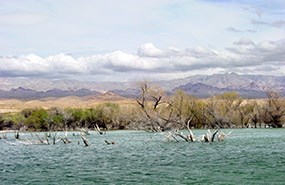
PHOTO BY JOSEPH BARNES, UNLV Long-term Limnological and Aquatic Resource Monitoring for Lakes Mead and Mohave Category 6: Wetland and riparian habitats associated with Lakes Mead and Mohave contain many water-dependant species such as honey mesquite, screwbean mesquite, catclaw acacia, cottonwood, true willows, wild grape, grasses, sedges, reeds, and other species. Many riparian plant species are phreatophytes whose roots extend into zone of saturation fed by groundwater, while others are species that depend on surface saturated soils such as those found in marshes. These areas are of significant biological importance to several animal species covered under the Clark County Multiple Species Habitat Conservation Plan including phainopepla, vermillion flycatcher, several species of lizards, and the sidewinder. However, many of these areas are being threatened with risk of degradation through associated human activities such as livestock grazing, off-road vehicle activity, unauthorized firewood gathering, dumping, illegal woodcutting, and groundwater withdrawals. Riparian-area integrity and health are also at risk from wildland fire and invasion of exotic species including red brome and tamarisk. Strategic Fundamental Objectives:
Management questions best answered by research:
|
Last updated: February 28, 2015
